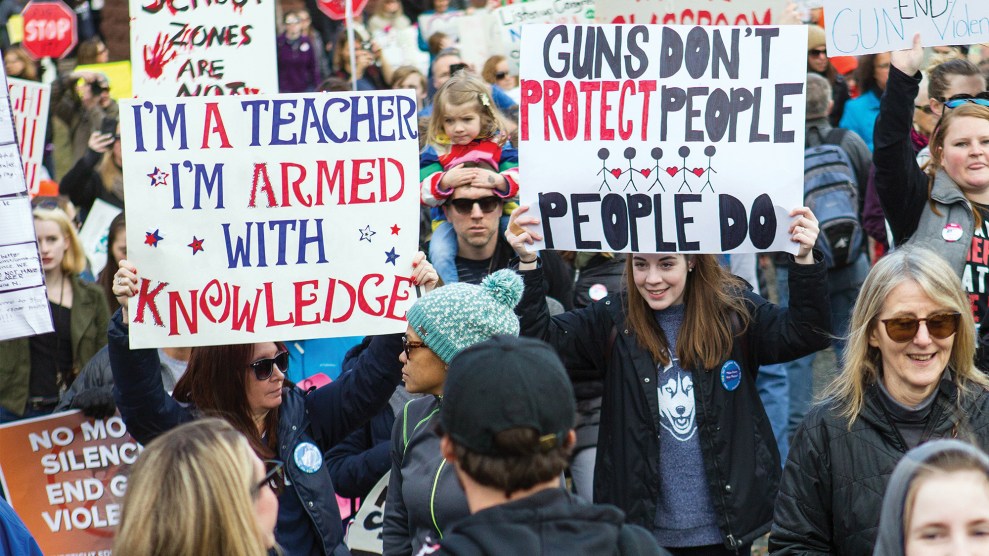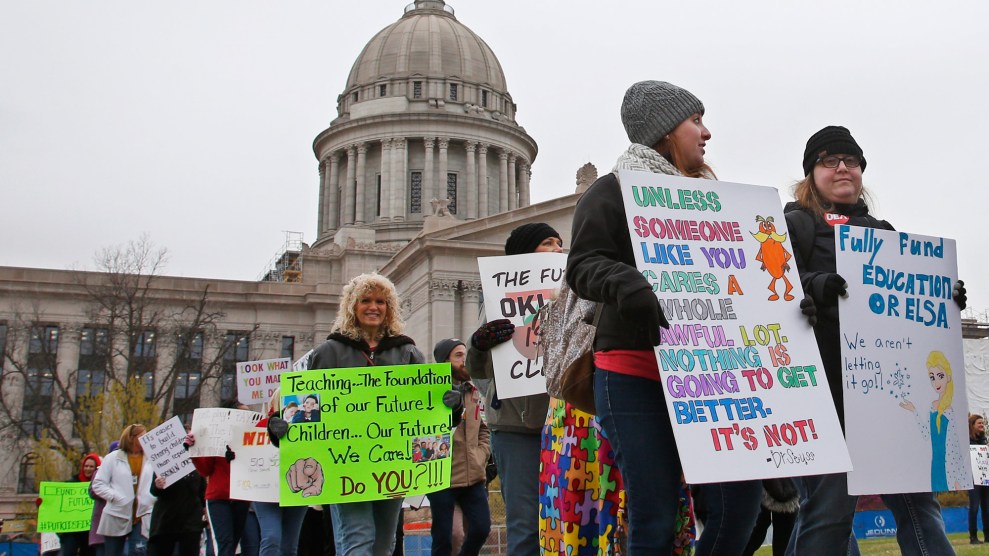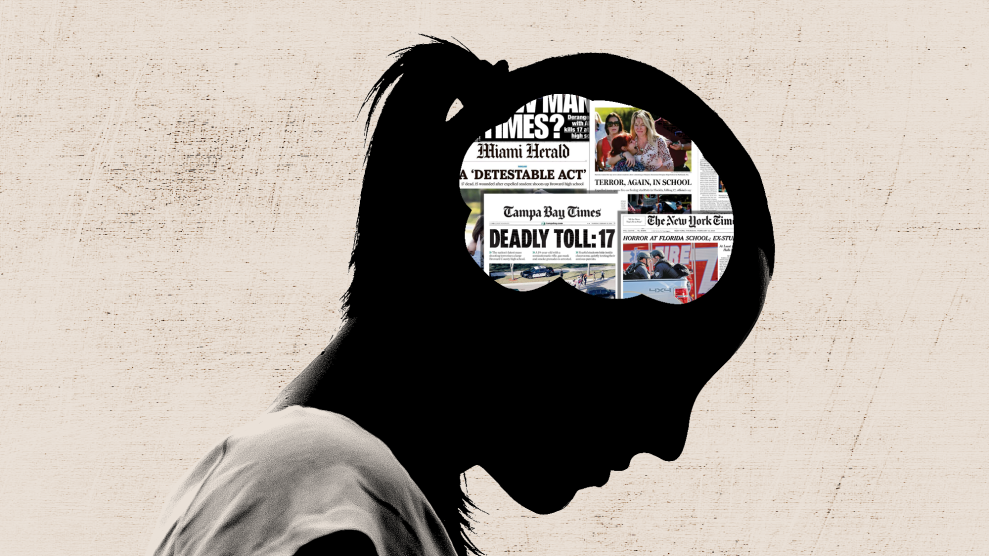
Mingo Nesmith/ZUMA
This article first appeared on TomDispatch.com.
During the first week of May 1963, more than 800 African-American students walked out of their classrooms and into the streets of Birmingham, Alabama, to call for an end to segregation. Despite frequent arrests and having dogs and high-pressure firehoses turned on them, they kept marching. Their determination and ceaseless bravery—later called the Children’s Crusade—was captured in photographs and newspaper articles across the country. Through acts of peaceful and defiant civil disobedience, these students accomplished what their parents had failed to do: sway public opinion in support of the civil rights movement.
Fast forward to March 24, 2018. Naomi Wadler, a fifth grader, is standing at a podium in front of hundreds of thousands of protesters at the March for Our Lives in Washington, DC. Young as she was, Wadler, who organized a walkout at her elementary school to honor the 17 victims of the Parkland massacre, delivered a searing and heartfelt speech about the countless gun-related deaths of black women in America. Her steely resolve and the power of her message brought me to tears. I wondered: Is this what it will take? Will a new generation of fearless student leaders be the agents of change that America so desperately needs?
As a teacher, it took me a while to begin to see just what my students truly had in them. During my first two years of high school teaching, I’m not sure I loved, or even liked, my students. If someone asked me about my job, I knew the right things to say—working with teenagers was challenging yet inspiring—but I didn’t believe the lip service I was paying the profession. Much of my initial experience in the classroom was emotionally draining, engaged as I was in power struggles with the students, trying to assert my influence and control over them.
It seemed so clear to me then: I was their teacher—they were my students. So I set out to establish a dynamic of one-way respect. I would provide information; they would listen and absorb it. This top-down approach was the model I’d observed and experienced my entire life. Adults talk, kids listen. So it couldn’t have been more unsettling to me when certain of those students—by sheer force of spirit, will, or intelligence—objected. They caused friction in my classroom and so I saw them as impediments to my work. When they protested by arguing with me or “talking back,” I bristled and dug in deeper. I resented them. They posed a continual threat to my ego and my position as the unassailable owner of the classroom stage.
Still, I knew something was wrong. In the quiet hours of the early morning I’d often wake up and feel a discomfort I can’t describe. I’d run through exchanges from the previous day that left me wondering if I was doing more harm than good. Yes, I continued to assert my right to the ownership of knowledge, but was I actually teaching anyone anything? I was—I could feel it—actively disregarding the emotional and intellectual capacities of my students, unwilling to see them as informed, competent, and worthy of being heard. I was, I realized, becoming the very kind of person I hated when I was in high school: the adult who demanded respect but gave none in return.
The best decision I ever made in a classroom was to start listening to my students.
As I slowly shifted the power structure in that room, my thinking about the way we look at youth and how we treat adolescents began to change, too. We ask teenagers to act like adults, but when they do, the response is often surprise followed by derision.
So it came as no real shock to me that, as soon as the students of Marjory Stoneman Douglas High School started to talk back to the “adults in the room”—the pundits, commentators, politicians, the NRA, members of other special interest groups, and even the president—they were met in some quarters with remarkable disdain. The collective cry from their opponents went something like this: There is no way a bunch of snotnosed, lazy, know-nothing teenagers have the right to challenge the status quo. After all, what do they know, even if they did survive a massacre? Why would watching their friends and teachers die in the classrooms and hallways of their school give them any special knowledge or right to speak out?
This nose-scrunching, finger-waving contempt for all things adolescent is a time-honored tradition. There’s even a name for it: ephebiphobia, or fear of youth. The ancient Greek philosopher Plato was quoted as saying: “What is happening to our young people? They disrespect their elders, they disobey their parents. They ignore the law. They riot in the streets, inflamed with wild notions. Their morals are decaying. What is to become of them?”
In some ways, Plato was right: The old should be fearful of the young. You see, the teenagers who marched after Parkland don’t necessarily hate the world; they just hate the particular world we’ve built for them. They’ve watched as the rules have been laid out for them, a status quo that seems to become grimmer, more restrictive, and more ludicrous by the week. Fight for an end to police violence against unarmed black civilians and you’re a terrorist. Kneel during the National Anthem and you’re un-American. Walk out of your school to force people to confront gun violence and you’re not grateful for your education. In short, whatever the problems in our world and theirs, there is no acceptable way to protest and no way to be heard. Not surprisingly, then, these teens have proceeded in the only way they know how: by forging new paths and ignoring what they’ve been told is immutable and impossible.
In doing so, these students have a distinct advantage over their elders. Adolescents understand the optics in a way most of their elders don’t. They’ve spent countless hours making YouTube and Snapchat videos and vlogging about their lives. They’re digital natives with the astonishing confidence to navigate the gauntlet of talking heads, corporate news sites, politicians, commentators, tweeting presidents, and anonymous trolls. They not only do this with remarkable conviction, but it seems to come naturally to them.
They’ve been raised not only to believe in themselves, but also to have faith that there’s an audience online for their beliefs. No wonder Rush Limbaugh has taken to calling David Hogg, one of the most prominent of the Parkland student protesters, “Camera Hogg.” No wonder many on the right have accused students like him of being “paid actors.” Hogg isn’t acting, of course. He’s simply a kid who has made practice perfect.
According to a 2017 report by the Bureau of Labor Statistics, American teenagers spend around 4.5 hours per day online, though that number may actually be low. In 2015, Common Sense Media conducted a study that found teens 13 to 18 average about nine hours of entertainment media use daily, “excluding time spent at school or for homework.” Two divergent paths emerge when considering such statistics. Follow one and the research supports the conclusion that excessive screen time has deleterious effects on the mental health and well-being of teenagers. Follow the other, and you find those same teenagers so finely attuned and well adapted to the landscape of social media they’ve become masters of the craft.
Hogg displayed exactly this mastery in his recent battle of wits with Laura Ingraham of Fox News. Ingraham had attempted to publicly humiliate the 17-year-old activist by tweeting condescendingly about how he had been rejected by four California colleges. Hogg proved himself savvier than his famous foe when, instead of responding directly, he jumped on Twitter to call for a boycott of Ingraham’s advertisers. More than a dozen quickly jumped ship—a devastating blow. And when she issued an anemic mea culpa, he responded on CNN by saying that her apology “was kind of expected, especially after so many of her advertisers dropped out.” In his measured appraisal of the situation lay a striking grasp of the established order. “I’m glad to see corporate America standing with me and the other students of Parkland and everybody else,” he said, “because when we work together we can accomplish anything.”
That exchange, a real-time adults vs kids Twitter war, had me riveted. The immediacy and efficacy of Hogg’s actions seemed to shatter the well-established dynamics between old and young. Hogg not only showcased his understanding of the way things work in America as being so much craftier than Ingraham’s—always go for the money—but he utilized the most powerful tool at his disposal to upend a seemingly bulletproof target. In doing so, he demonstrated that young people are capable of speaking far more resonantly than their parents or grandparents could have imagined. The question, of course, remains: Will the rest of us listen to them?
When focused through collective grief, anger, and urgency, the energy and passion that defines youth can be a powerful stimulus for change. The inherent ridiculousness of the argument against youth-led movements—that students have no platform on which to stand—pointedly overlooks the role of youth as catalysts for social transformation. From the Children’s Crusade to student protesting the Vietnam War, adolescents (and sometimes even children) have regularly been on the front lines of social change.
The argument against listening to children is often made by those who forget what it’s like to be young. The daily lives of adolescents are, after all, deeply involved in thinking, assessing, analyzing, and evaluating. Nine months out of the year, whether they like it or not, they are actively engaged in education. By the time they graduate from high school, 18-year-olds in Oregon, where I teach, have spent close to 15,000 hours in the classroom. It should come as no surprise that after so many years of being taught how to give speeches, make arguments, support claims with evidence, and study the past, many teenagers are quite articulate and well-positioned to grasp the nature of the world they are about to enter. Whether they fully know it or not, they’re regularly being forced to ask the “big” questions about a messy world and beginning to form their own life philosophies.
Yes, just as I felt in my first two years as a teacher, teenagers can be maddeningly self-absorbed. But, as the Parkland students made obvious, kids on the threshold of adulthood can also be astute observers of the world—sometimes strikingly more so than the adults who are supposed to provide them with wisdom. They’re deeply passionate about the things they love, and rightfully skeptical of the world they will inherit.
Asking teenagers to accept the depressing realities of the society we’re bequeathing to them without responding, let alone protesting, is tantamount to teaching without listening. My students know that loan debt for their college-age compatriots is $1.3 trillion and counting. It’s a subject that comes up in class all the time. Students ask me how they’re supposed to pay for college without incurring lifelong, crippling debt, and I can’t give them a reasonable answer. But of course, they don’t really expect me to.
They’ve been told that the richest 20 percent of Americans hold 84 percent of the nation’s wealth, while the bottom 40 percent own less than 1 percent. They can see those vast disparities for themselves in their own lives, in their classrooms. They know this country is over-weaponized and that neither “hunting” nor the “Second Amendment” can account for it. They’ve grappled with the terrifying reality that they could be gunned down in their own school, at the movies, at a concert, or even outside their homes. When we practice active-shooter drills in the classroom, those fears are only confirmed. They see that adults can’t protect them and so they draw the necessary conclusions. So when they disrespect institutions, rules, beliefs, and traditions that look like relics from a past that has wantonly jeopardized their future—and when they disrespect the adults who seem to uphold those traditions—shouldn’t we take notice?
Here’s one thing that shouldn’t surprise anyone. Teachers, exposed daily to these very teens, have been among the first to collectively follow them out of the classrooms and into the streets. The strikes and walkouts in Oklahoma, Kentucky, and West Virginia indicate that support for grassroots movements is building and that adults are, in their own ways, beginning to stand with and support the young.
Those teachers, often in the streets without the support and assistance of their unions (when they even have them), have opted to harness the energy, momentum, and social-media savvy of all the recent youth activism to make their demands heard. Noah Karvelis, a new teacher in Arizona, described his colleagues as “primed for activism by their anger over the election of President Trump, his appointment of Betsy DeVos as education secretary, and even their own students’ participation in anti-gun protests.”
The striking teachers are demanding changes that will benefit not just them but ultimately their students. Yet their detractors have opted to respond by shaming the teachers and dismissing their calls for reasonable funding and support as so many petty complaints. Gov. Mary Fallin of Oklahoma even compared her state’s striking teachers to a teenager who “wants a better car.” In doing so, she highlighted one thing: The greatest insult you can hurl at a teacher is to compare them to their students.
Teenagers are indeed infuriating. They can be rude, naïve, and-short sighted. But then, so can adults. Dismissing adolescents for the fact of their youth and denying them the right to be heard just makes the rest of us look like the enemy. All I can say in response is that this teacher is standing firmly with her students—and the hundreds of thousands of others who are collectively demanding a voice.
Belle Chesler teaches visual arts in Beaverton, Oregon.















